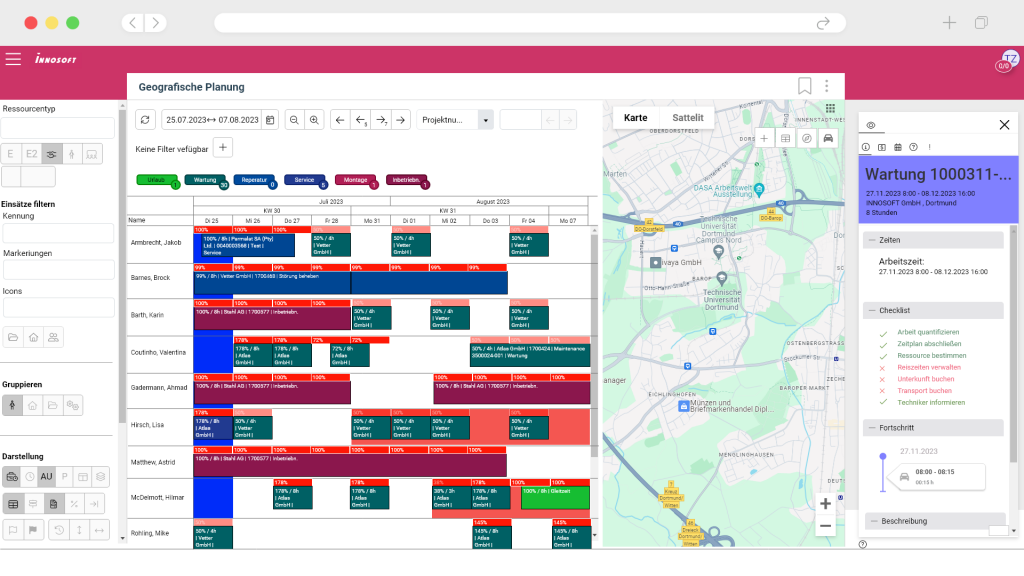Efficient planning is crucial for smooth operations in many companies. Whether in production, project management, or technical field service, a clear overview of resources and deadlines forms the basis for reliable decisions. The planning board is one of the classic tools used in this context. It helps to clearly display tasks and organize order planning efficiently.

What is a planning board?
A planning board (also known as a resource planning board) is a central tool for dispatchers to plan and visualize technician assignments. Originally used as a physical board, it serves to visualize processes within a company and present plans in a structured manner. Appointments, employees, or machines can be displayed in an organized manner and assigned to specific tasks. The planning board helps to keep track of current capacities and make planning decisions in a transparent manner.
How does a planning board work in practice?
Key information for resource and resource planning is displayed visually on the planning board. The planning board forms a central basis for daily order planning and shows at a glance which assignments are scheduled for when and with what capacities. It shows at a glance which orders are planned for when and with what capacities. The arrangement of the data plays an important role here: Typically, the Y-axis has a list of resources, grouped by teams or locations. The X-axis shows the timeline, displayed in days or weeks. A planned assignment appears as a colored bar in the row of the respective technician, starting with the planned start time and ending with the end of the order.
This display gives the dispatcher a structured view of all planned activities. Assignments can be checked in relation to each other and adjustments can be made directly. If technicians are accidentally double-booked, this is immediately apparent. In this way, the planning board supports the smooth coordination of available capacities and upcoming tasks.
Efficient use of resources through targeted planning board control
A central planning tool helps to control processes in the company in a targeted manner. It creates the basis for planning appointments, resources, and orders. The aim is to organize the use of existing capacities in such a way that bottlenecks can be identified at an early stage and idle times can be avoided.
The structured display provides clarity about the current planning status. Technicians, projects, or machines can be assigned according to requirements. In this way, the planning board helps to shorten response times, better coordinate processes, and improve the utilization of existing resources.
How do digital and analog planning boards differ?
Analog planning boards are often used in smaller businesses or workshops. They usually consist of a physical board with magnets, index cards, or labeled strips. Changes are made manually directly on the wall and are immediately visible, but cannot be tracked automatically.
Digital planning boards display the same planning information with the advantage that data can be maintained centrally and updated in real time. They can be integrated into existing systems and accessed from different locations. Filter and search functions as well as automatic conflict alerts provide additional support in everyday planning.

How does a digital planning board improve resource utilization?
Digital planning boards support scheduling with intelligent functions that go beyond mere visualization. They enable targeted capacity control, promote teamwork, and integrate current system data directly into planning. This results in reliable processes with minimal coordination effort. The following features demonstrate the advantages of a digital planning board:
- Direct planning: New assignments can be created with a double click, and existing ones can be moved or extended using drag and drop. The software checks parameters such as availability, qualifications, or existing bookings in the background.
- Flexible views: Resources can be displayed not only by person, but also by machine, customer, or project, depending on the issues at hand.
- Clear visualization: Colors, symbols, and progress indicators provide orientation. Absences, order types, and processing statuses can be quickly identified.
- Cross-module data: The planning board uses information from linked modules such as tickets, projects, or maintenance plans. Changes can automatically trigger follow-up actions, such as customer notifications or feedback from the field.
- Flexible time views: The digital planning board can be displayed at different zoom levels as required – from daily to weekly to monthly views. This allows dispatchers to keep an eye on both short-term assignments and longer-term planning.
- Shared planning status: In meetings, the digital planning board provides a visual basis for coordinating assignments. It can be displayed on a large screen or online so that everyone involved has the same level of information.
Structure in everyday life through digital planning tools
Plan precisely, respond flexibly, and keep track of all assignments. Innosoft’s digital planning board helps you optimize resource allocation and display current planning statuses transparently—for reliable processes, smooth coordination, and informed decisions in your day-to-day business.
Manage resources: Plan efficiently with Innosoft’s software solution
Forward-looking resource planning begins with a structured overview of deadlines, resources, and tasks. Innosoft’s software solution helps you coordinate processes in a targeted manner and make informed decisions based on current order planning data.
The central linking of order, resource, and location data allows you to quickly identify connections — for example, bottlenecks in certain teams, changing priorities, or regional availability. Adjustments have a direct effect on all affected areas and ensure consistent processes throughout the entire planning system. Intelligent filter and evaluation functions enable you to analyze current capacity utilization and make sensible use of reserves.
For companies, this means more stable processes, traceable decisions, and better coordination between scheduling, field service, and other parties involved. This results in realistic deployment plans with clear responsibilities— even in the event of short-term changes or complex project structures.
Would you like to find out how Innosoft can improve your resource planning? We would be happy to show you how you can increase coordination and efficiency in the long term.
Contact us for more information about our FSM software!


